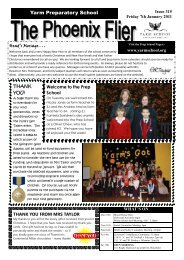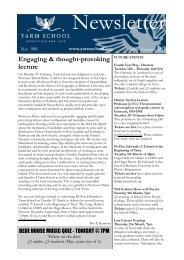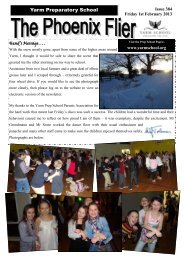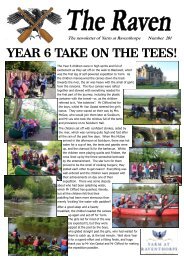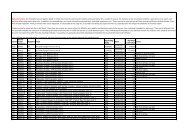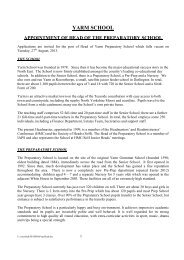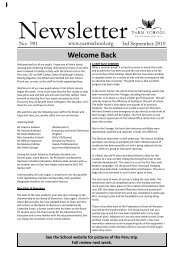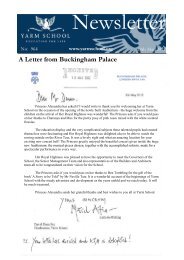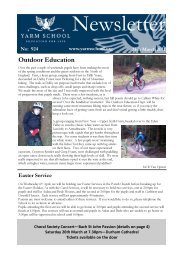yarm at raventhorpe disability access policy - Yarm School
yarm at raventhorpe disability access policy - Yarm School
yarm at raventhorpe disability access policy - Yarm School
You also want an ePaper? Increase the reach of your titles
YUMPU automatically turns print PDFs into web optimized ePapers that Google loves.
YARM AT RAVENTHORPE<br />
DISABILITY ACCESS POLICY<br />
<strong>Yarm</strong> <strong>at</strong> Raventhorpe <strong>School</strong> is a selective, coeduc<strong>at</strong>ional, independent school. All pupils<br />
must s<strong>at</strong>isfy the entry criteria which are detailed in our Admissions Policy. Full details of the<br />
<strong>School</strong>’s Admissions Policy can be found in the relevant <strong>policy</strong> documents. Pupils entering<br />
Key Stage 2 must also have a supportive school reference. When applying for a place in the<br />
<strong>School</strong>, or <strong>at</strong> any time when <strong>at</strong>tending the <strong>School</strong>, parents are encouraged to inform us about<br />
any special needs of their child. The <strong>School</strong>, which is fully committed to equality of<br />
opportunity, will do all it reasonably can to address the special needs of any child in its care.<br />
Special Needs and Disability Act, 2001<br />
The SENDA amends part 4 of the Disability Discrimin<strong>at</strong>ion Act (1995). It extends the rights<br />
given to individuals and the duties imposed on organis<strong>at</strong>ions, to schools and LEAs in terms of<br />
their responsibilities to deliver educ<strong>at</strong>ion. Individuals are not liable for their actions but the<br />
‘responsible body’ (the school) is expected to ensure th<strong>at</strong> the actions and behaviour of its<br />
staff are not discrimin<strong>at</strong>ory.<br />
Key Imper<strong>at</strong>ives (definitions)<br />
A person on account of his/her <strong>disability</strong> shall not be tre<strong>at</strong>ed in a way th<strong>at</strong> is less favourable<br />
than a person who does not have a <strong>disability</strong>.<br />
A <strong>disability</strong> is…<br />
A physical or mental impairment which has a substantial and long-term effect on the person’s<br />
ability to carry out normal day-to-day activities. Disabilities can be both seen and/or hidden.<br />
Not all children defined under the DDA will have SEN, e.g. children with severe asthma,<br />
arthritis or diabetes. The DDA ensures th<strong>at</strong> disabled pupils are not discrimin<strong>at</strong>ed against.<br />
Whole school approaches aimed <strong>at</strong> inclusion are likely to best address a school’s duties under<br />
both sets of requirements.<br />
Less Favourable Tre<strong>at</strong>ment<br />
The <strong>School</strong> can ensure th<strong>at</strong> less favourable tre<strong>at</strong>ment could not occur by considering the<br />
following questions :
• Could tre<strong>at</strong>ment be less favourable for a reason th<strong>at</strong> is rel<strong>at</strong>ed to a child’s<br />
<strong>disability</strong>?<br />
• Could the tre<strong>at</strong>ment be viewed as less favourable than someone gets if the reason<br />
for the tre<strong>at</strong>ment does not apply to him/her?<br />
• Could the tre<strong>at</strong>ment be viewed as less favourable than can be justified?<br />
Discrimin<strong>at</strong>ion will occur where schools have failed to take ‘reasonable steps’ which leads to<br />
disabled pupils or prospective pupils being placed <strong>at</strong> a ‘substantial disadvantage’.<br />
At <strong>Yarm</strong> <strong>at</strong> Raventhorpe <strong>School</strong>, the duty of care and responsibility to take reasonable steps<br />
applies to all staff including managers, teaching staff, learning support assistants, c<strong>at</strong>ering<br />
staff, caretakers and others involved in providing or supporting learning.<br />
EXAMPLES OF SPECIAL NEEDS WHICH HAVE BEEN ACCOMMODATED<br />
RECENTLY<br />
Visual Impairment<br />
• Provision of enlarged m<strong>at</strong>erials and examin<strong>at</strong>ion/assessment papers.<br />
• Encouragement to word process.<br />
• Provision of whiteboards and range of coloured pens.<br />
• Good lighting.<br />
• Ensure student is se<strong>at</strong>ed where he/she can see best.<br />
• The use of coloured overlays to reduce paper glare.<br />
• Ensure th<strong>at</strong> all teachers are aware of the <strong>disability</strong> and str<strong>at</strong>egies to address it.<br />
Significant hearing loss<br />
• Discuss issue with parents.<br />
• Discuss with sensory service – training provision.<br />
• Ensure child is se<strong>at</strong>ed close to aural stimulus.<br />
• Ensure all teachers are aware of <strong>disability</strong> and str<strong>at</strong>egies to assist.<br />
Dyslexia<br />
• Provide support lessons to overcome literacy problems.<br />
• Encourage differenti<strong>at</strong>ed teaching methodology.<br />
• Willingness of teachers to mark full content r<strong>at</strong>her than spelling.<br />
• Encourage the use of word processing.<br />
• Accept work in diagramm<strong>at</strong>ic form etc.<br />
• Help with personal organis<strong>at</strong>ion and homework diary.<br />
• Provide extra time in assessments/exams.<br />
• Ensure th<strong>at</strong> all teachers are aware of the <strong>disability</strong> and str<strong>at</strong>egies to assist.<br />
• Screening <strong>at</strong> Year 3 and new entrants in older year groups.
Dyspraxia<br />
• Encourage differenti<strong>at</strong>ed teaching methodology.<br />
• Accept work in word process/diagramm<strong>at</strong>ic form.<br />
• Help with organis<strong>at</strong>ion and homework diary.<br />
• Provide extra time for assessment/examin<strong>at</strong>ion.<br />
• Encourage support from the PE Department.<br />
Attention Deficit Disorder<br />
• Train teachers to understand need to accommod<strong>at</strong>e “poor” behaviour.<br />
• Agreed range if discrete reminders to bring pupil back to task.<br />
• Breaking down of tasks into small chunks.<br />
• Rewards for staying on task.<br />
• Help with homework diary entries<br />
• Ensure th<strong>at</strong> all teachers are aware of special needs.<br />
Physical Difficulties<br />
• Consider individual timetable of pupil and <strong>access</strong> to the curriculum – make any<br />
necessary and reasonable timetable changes.<br />
• Use of technology to assist – laptop?<br />
• Allow extra time for circul<strong>at</strong>ion around school/work tasks etc.<br />
• Ensure th<strong>at</strong> teachers are aware of special need.<br />
• Assist with pupil helper if necessary.<br />
• Provide for special arrangements regarding personal hygiene, privacy etc as required.<br />
If used, the <strong>School</strong>’s Health & Safety Advisor is responsible for ensuring th<strong>at</strong> all pupils and<br />
staff, where applicable, are inducted on the ‘safe use’ of crutches / walking aids in and around<br />
school. Following a brief introduction, a completed induction form is presented to the<br />
affected person, together with a ‘Walking aids pamphlet compiled by the NHS.<br />
It is the responsibility of the Form Teacher to inform the H & S Advisor when a pupil arrives<br />
in school for the first day with either crutches or walking aids. In the case of an employee, it<br />
is their responsibility to in form the H & S Advisor.<br />
ACCESS PLAN: 1 st APRIL 2006 to 31st MARCH 2009 and 1 st APRIL 2009 – 31st<br />
MARCH 2012<br />
The current site of <strong>Yarm</strong> <strong>at</strong> Raventhorpe <strong>School</strong> prevents the provision of immedi<strong>at</strong>e <strong>access</strong><br />
to all pupils with disabilities as lifts and low-level entries are not available in all buildings.<br />
The <strong>access</strong> action plan outlined below takes this into account and presents str<strong>at</strong>egies and<br />
options for improving <strong>access</strong>ibility within existing arrangements. By its very n<strong>at</strong>ure, this<br />
action plan covers both the short, medium and long term.<br />
• Currently the ground floor of the main <strong>School</strong> building can be <strong>access</strong>ed by the<br />
disabled in wheel chairs via the main entrance doors and the ground floor is on one<br />
level.
• An audit of the school site has been completed by the Est<strong>at</strong>es Manager and Health and<br />
Safety Officer in consult<strong>at</strong>ion with the Special Educ<strong>at</strong>ional Needs Co-ordin<strong>at</strong>or<br />
(SENCO) (for each site) or their design<strong>at</strong>ed represent<strong>at</strong>ives.<br />
• Any future building projects must take <strong>disability</strong> <strong>access</strong> requirements into account.<br />
For instance, low level ramps as well as steps; widening of main doorways to allow<br />
wheelchair <strong>access</strong>; handrails on both sides of ramps etc.<br />
• Staff training needs should be subject to regular audit. This is especially important<br />
when pupils with a known <strong>disability</strong> need to move through the school and encounter<br />
staff new to them. Experience of new members of staff should be established and any<br />
training needs addressed. Acceptance of new pupils who have disabilities into the<br />
school will trigger the need for further staff training. This is monitored by the Head.<br />
• Medical needs for individual pupils are coll<strong>at</strong>ed. Photographs of pupils with severe<br />
medical needs (e.g. anaphylaxis, epilepsy) together with a brief individual action plan<br />
are displayed on the staff notice board. The <strong>School</strong> Nurse actions this.<br />
• Pupils requiring Individual Educ<strong>at</strong>ion Plans (IEPs) must have these forms upd<strong>at</strong>ed<br />
regularly as agreed in the Special Educ<strong>at</strong>ion Needs <strong>policy</strong> and the SENCO should<br />
keep copies of these in a file and ensure th<strong>at</strong> staff who teach those pupils are fully<br />
informed. These IEPs should clearly specify any particular resources required to<br />
accommod<strong>at</strong>e learning needs. Teaching staff are provided with a file containing<br />
inform<strong>at</strong>ion about pupils receiving learning support.<br />
• Teaching assistants in the Early Years follow the IEPs with individual pupils during<br />
assembly times.<br />
• Access to the curriculum must be provided to the best of the <strong>School</strong>’s ability. Where<br />
timetables need to be adjusted (e.g. to provide ground level accommod<strong>at</strong>ion) this<br />
should be undertaken although it is recognised th<strong>at</strong> the full curriculum may not be<br />
able to be <strong>access</strong>ed dependent upon the need and <strong>disability</strong> of the pupil.<br />
• The <strong>School</strong> Library is not <strong>access</strong>ible without using stairs but the Library books can be<br />
delivered via Form Teachers or pupils.<br />
• Unexpected disabilities. The school must react to unexpected situ<strong>at</strong>ions and do all<br />
th<strong>at</strong> is reasonable to accommod<strong>at</strong>e the needs of pupils. These situ<strong>at</strong>ions may be due to<br />
accidents (broken leg, damaged eye etc..) or may be as a result of the onset of<br />
debilit<strong>at</strong>ing illness. It would be reasonable to expect th<strong>at</strong>, where possible, timetable<br />
adjustments should be made to enable th<strong>at</strong> pupil to <strong>access</strong> as much of the curriculum<br />
as possible.<br />
• The <strong>School</strong> is committed to working with parents and specialist agencies, such as the<br />
RNIB to ensure th<strong>at</strong> all reasonable practicable help is available.
• Special provision will be made, as far as is practicable, to allow pupils to take full<br />
advantage of all school trips and visits. An individual risk assessment will be<br />
prepared, as necessary.<br />
• In Physical Educ<strong>at</strong>ion provision will be made wherever practicable for activities<br />
within the range of the pupil so th<strong>at</strong> they can develop appropri<strong>at</strong>e skills and strengths.<br />
This must not be <strong>at</strong> the expense of denying opportunities to other pupils.<br />
ROLE OF THE GOVERNING BODY AND THE HEAD<br />
It is the duty of the Head to deleg<strong>at</strong>e or assume responsibility to ensure th<strong>at</strong> the Disability<br />
Access Policy is applied and monitored. The Head should be aware <strong>at</strong> all times when<br />
making decisions regarding school premises of the requirements of the Disability Access<br />
Policy and ensure th<strong>at</strong> due regard is paid to it. The Head should also make any necessary<br />
recommend<strong>at</strong>ions to the Governing Body rel<strong>at</strong>ing to the Policy and provision for its<br />
implement<strong>at</strong>ion.<br />
This Policy should be reviewed every two years by the Head and relevant inform<strong>at</strong>ion and<br />
implic<strong>at</strong>ions/needs shared with the, Headmaster, <strong>School</strong> Nurse, Health and Safety<br />
Officer, Est<strong>at</strong>es Manager and SENCOs.<br />
POLICY DATE : SEPTEMBER 2007<br />
Reviewed : August 2008<br />
Revised : June 2009<br />
Reviewed: January 2010



